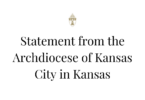
by Joe Bollig
joe.bollig@theleaven.org
Traditionally, Catholics have relied on the three pillars of Lent to guide them in preparing their souls for Easter. The three pillars are prayer, fasting and almsgiving.
The purpose of these Lenten devotional practices is to open ourselves to conversion, repentance and a more intimate relationship with God.
There are a lot of things you can do for Lent at home as a family when you consider the following:
- There are many forms and ways of prayer
- Fasting and abstaining can involve many other things than just food. It can involve something normally considered good (a favorite food or activity) or breaking a habit that leads us to sin (gossip or holding grudges).
- Almsgiving is about giving to others in need. Giving includes not only money but also love, time, talent, attention and material goods.
Prayer
First and foremost, families need to make every effort to participate as a family in the activities and liturgies offered at their parishes.
These include seeking out the sacrament of reconciliation, Stations of the Cross, eucharistic adoration, parish missions and retreats.
If it’s more practical, consider making short visits to the church on quiet afternoons as a family to pray the Stations, adore Jesus in the tabernacle or light a votive candle. Take time to explore the church and “read” the symbolism in the walls, windows, layout and liturgical art or furnishings.
Now then, let’s take it back home.
- Construct a purple paper prayer chain. Take sheets of purple construction paper and cut them into strips about 1 inch wide and about 5 inches long. Place them in a box or basket with some pencils, markers or pens and some clear tape. Each day, gather as a family to write prayer intentions on the strips, pray and then use the tape to make each strip a link in a paper chain.
- Hang the growing chain in a prominent place. Burn the chain and scatter the ashes on Good Friday. Talk about the color purple in Lent and its dual meaning of penance and royal dignity. Talk about how God wants us to pray.
- Memorize a prayer. Start with the basics like the Our Father, Hail Mary, Glory Be, Act of Contrition, Prayer to St. Michael the Archangel or Memorare.
- Read. Go to a Catholic bookstore and buy something to read for Lent. Buy children’s books to read for daily story times. If you don’t want to buy a book, borrow books from your parish religious education program or public library.
- Pray a family rosary. Gather for a weekly or daily rosary or Divine Mercy chaplet. If this is too much, consider praying single mysteries and decades after family meals. Rosaries can be prayed at home, on walks or in the car.
- Make a home altar. This is an old Catholic practice that was quite common. Home altars are simple devotional places, such as a small table against a wall or a stand in a corner.
- You can place in this area a crucifix, icon, statue, Bible, rosary, candles, bottle of holy water, holy cards of patron saints and other items. You can also place items associated with Lent there: nails, a crown of thorns, a cross, a dish of ashes, crackers (symbolizing unleavened bread) and so on. If you wish, you can set up some comfortable chairs or something to kneel on for prayer times, or merely gather and pray while standing.
- Start a family Bible time. Pick verses that relate to the paschal mysteries. Print them out and cut them into strips. Place them in a box or jar and have a family member take one out at mealtimes and read. Save the strips to make into a paper chain.
- Make a cemetery visit. Take walks through a Catholic cemetery and pray for those buried there. Discuss purgatory, heaven and hell. Discuss how Jesus died to save us from our sins and rose from the dead to bring us eternal life.
Fasting
Traditionally, fasting means eating less food, while abstaining means not eating a certain kind of food. Both are done as penitential acts and for self- denial.
Ash Wednesday and Good Friday are obligatory days of fasting and abstaining from eating meat. Additionally, each Friday during Lent is a day of abstinence from meat.
The Lenten regulations concerning fasting and abstinence will appear in The Leaven, on the archdiocesan website and in parish bulletins.
But our Lenten fasting and abstinence can go way beyond what is regulated. Many people choose to “give up something for Lent” — a food or a behavior — as a form of penance or self-denial in order to grow in holiness.
Lent is a great time to have conversations with your kids about the reasons and benefits of fasting and abstinence.
- Compile an accountability list/calendar: Make a list of things to fast or abstain from. Have each family member choose one or more things to fast or abstain from through Lent, or make a Lenten calendar and choose things to abstain from for each day or week.
- Here is a list: complaining, calling names, arguing, negativity, sarcasm, laziness, being picky, judging others, anger, lying, cursing, snacking, TV, social media, screen time, video games, the Internet, favorite treats or snacks, sugar, coffee or soda pop, candy and spending excessive time on your smartphone. Of course, you can always add your own items!
- Reject materialism: Have a spring cleaning and clearing on a designated Saturday. Sort through old clothes, toys and other items and give them to a parish rummage house, Catholic Charities, Goodwill, the Salvation Army or Disabled American Veterans thrift stores. Talk about the importance of not letting materialism take over our lives and instead valuing our relationship with God above all earthly things.
Almsgiving
Almsgiving is basically giving money to the poor. But the key concept is the “giving” to meet the needs of someone else. This doesn’t always mean money.
- Have a family poor box. For many years, kids have saved small change and placed them in paper “Rice Bowls” to benefit Catholic Relief Services. This is great, but families can also make their own Lenten family “poor box” and collect money to be given to a designated charity or ministry at the end of Lent.
- Visit a nursing home. Giving your time and attention can be a wonderful thing. Decorate some Easter baskets and fill them with goodies or personal care items. Give the basket or items to the residents. Be sure to call ahead and ask what things are needed or prohibited, or if there are special requests or considerations.
- Stock a food pantry: Collect and donate food and personal care items to a food pantry. Contact the pantry to see if there is a need for particular items.
- Make Easter cards and visits. Identify the elderly or shut-ins of your neighborhood. Make homemade Easter cards and hand-deliver them. Ask residents if they need help shoveling snow, raking leaves or other tasks that are difficult for them.
- Volunteer. Volunteer as a family to work at a soup kitchen or with Catholic Charities.
- Perform acts of charity. Keep a list of little acts of charity done to other members of the family. These could include paying compliments, sharing and doing extra chores.
- Reach out. Call and/or write to someone with whom you’ve fallen out of contact, especially family.
- Enjoy family time. Take the time you would normally spend on individual pursuits (video games, Internet, social media) and spend it on family activities. Hold a family meeting and make a list of games, activities and fun places to go as a family.
- Celebrate the gift of faith. Talk to someone about Jesus. Invite someone you know who is Catholic but no longer practices the faith to attend a Holy Week service, Easter Vigil or Easter Sunday Mass with you, followed by Easter dinner.
The taste of Lent
It might be fun (and a teachable moment) to gather the kids in the kitchen to make pretzels.
Pretzels are a traditional Lenten food that dates from the fifth century. The name in German means “little arms,” because its shape reminded people of arms crossed in prayer.
According to one legend, the pretzel was invented by a monk as an incentive for children to learn their prayers.
Pretzels were also a practical replacement of the usual mealtime bread that could not be made because of Lenten restrictions on using milk, eggs and fats (like butter).
Here’s a simple recipe:
Ingredients:
- ¼ cup water (85 degrees)
- 1 tablespoon dry yeast
- ½ teaspoon sugar
- 4 ½ cups flour
- 1 egg yolk
- 1 to 2 teaspoons water or milk
- Coarse salt
Directions:
Let the yeast and sugar dissolve in water for one hour. Add flour to yeast mixture and beat until smooth. Knead mixture for seven to eight minutes. Place in a greased, covered bowl and let the dough rise until it doubles in size. Divide the dough in half; then divide each half into smaller pieces of equal size. Roll each piece in your hands to make pencil shapes 12 to 15 inches long. Shape each length of dough into pretzels. Place them on a greased baking sheet. Brush them with egg yolk and water or milk mixture. Sprinkle with coarse salt. Bake at 325 degrees until lightly browned on top.
As you make the pretzels, talk about the meaning of Lenten fasting and abstinence. Note the pretzel’s crossed arms and talk about the importance of prayer. Pray before making and eating them.






